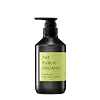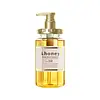What's inside
What's inside
 Key Ingredients
Key Ingredients

 Benefits
Benefits

 Concerns
Concerns

 Ingredients Side-by-side
Ingredients Side-by-side

Water
Skin ConditioningOcimum Basilicum Leaf Water
MaskingCocamidopropyl Betaine
CleansingSodium Lauroyl Methylalanine
Tea-Cocoyl Glutamate
CleansingCocamide DEA
EmulsifyingSodium Methyl Cocoyl Taurate
CleansingCitrus Aurantium Dulcis Peel Oil
MaskingPelargonium Graveolens Oil
MaskingOrange Roughy Oil
Skin ConditioningCitrus Limon Peel Oil
MaskingCymbopogon Martini Oil
MaskingChamomilla Recutita Oil
MaskingHydrolyzed Soy Protein
HumectantHydrolyzed Rice Protein
Skin ConditioningTheobroma Grandiflorum Seed Butter
Skin ConditioningSodium Dilauramidoglutamide Lysine
HumectantPyrus Cydonia Fruit Extract
Skin ConditioningEthyl Macadamiate
Skin ConditioningOlea Europaea Fruit
AbrasiveLauramidopropyl Betaine
CleansingGlycerin
HumectantCamellia Seed Oil
Polyquaternium-10
Borago Officinalis Seed Oil
EmollientCaesalpinia Spinosa Gum
Skin ConditioningPrunus Avium Fruit Extract
Skin ConditioningButylene Glycol
HumectantVanilla Planifolia Fruit Extract
Skin ConditioningStearamidopropyl Dimethylamine
EmulsifyingLemongrass Oil
Sodium Benzoate
MaskingLavandula Hybrida Oil
EmollientCitric Acid
BufferingPhytic Acid
Citrus Grandis Peel Oil
MaskingSodium Chloride
MaskingCitrus Limon Fruit Oil
AstringentPotassium Hydroxide
BufferingRose Flower Oil
MaskingDisodium EDTA
Melissa Officinalis Leaf Oil
MaskingPotassium Sorbate
PreservativeThymus Vulgaris Flower/Leaf Oil
MaskingSilver Oxide
AntimicrobialMelaleuca Alternifolia Leaf Oil
AntioxidantLauramidopropyl Hydroxysultaine
CleansingTocopherol
AntioxidantEucalyptus Dives Leaf Oil
PerfumingDiisostearyl Malate
EmollientCucumis Sativus Fruit Extract
EmollientMalic Acid
BufferingCoriandrum Sativum Fruit Oil
MaskingArginine
MaskingMentha Piperita Oil
MaskingWater, Ocimum Basilicum Leaf Water, Cocamidopropyl Betaine, Sodium Lauroyl Methylalanine, Tea-Cocoyl Glutamate, Cocamide DEA, Sodium Methyl Cocoyl Taurate, Citrus Aurantium Dulcis Peel Oil, Pelargonium Graveolens Oil, Orange Roughy Oil, Citrus Limon Peel Oil, Cymbopogon Martini Oil, Chamomilla Recutita Oil, Hydrolyzed Soy Protein, Hydrolyzed Rice Protein, Theobroma Grandiflorum Seed Butter, Sodium Dilauramidoglutamide Lysine, Pyrus Cydonia Fruit Extract, Ethyl Macadamiate, Olea Europaea Fruit, Lauramidopropyl Betaine, Glycerin, Camellia Seed Oil, Polyquaternium-10, Borago Officinalis Seed Oil, Caesalpinia Spinosa Gum, Prunus Avium Fruit Extract, Butylene Glycol, Vanilla Planifolia Fruit Extract, Stearamidopropyl Dimethylamine, Lemongrass Oil, Sodium Benzoate, Lavandula Hybrida Oil, Citric Acid, Phytic Acid, Citrus Grandis Peel Oil, Sodium Chloride, Citrus Limon Fruit Oil, Potassium Hydroxide, Rose Flower Oil, Disodium EDTA, Melissa Officinalis Leaf Oil, Potassium Sorbate, Thymus Vulgaris Flower/Leaf Oil, Silver Oxide, Melaleuca Alternifolia Leaf Oil, Lauramidopropyl Hydroxysultaine, Tocopherol, Eucalyptus Dives Leaf Oil, Diisostearyl Malate, Cucumis Sativus Fruit Extract, Malic Acid, Coriandrum Sativum Fruit Oil, Arginine, Mentha Piperita Oil
Water
Skin ConditioningLauramidopropyl Betaine
CleansingSodium C14-16 Olefin Sulfonate
CleansingSodium Lauroyl Taurate
CleansingGlycerin
HumectantCocamide DEA
EmulsifyingTea-Lauroyl Methylaminopropionate
CleansingTea-Cocoyl Glutamate
CleansingParfum
MaskingPolyquaternium-10
Sodium Benzoate
MaskingMyristyl Betaine
CleansingPhenoxyethanol
PreservativeCitric Acid
BufferingDisodium EDTA
Polyquaternium-47
Skin ConditioningMenthol
MaskingCaramel
Cosmetic ColorantHoney
HumectantArginine
MaskingPanthenol
Skin ConditioningArgania Spinosa Kernel Oil
EmollientShea Butter Glycereth-8 Esters
CleansingButylene Glycol
HumectantGluconobacter/Honey Ferment Filtrate
Skin ConditioningPPG-7
Skin ConditioningAcacia Senegal Gum
MaskingHoney Extract
HumectantCoco-Glucoside
CleansingKeratin
Skin ConditioningHydrolyzed Honey Protein
Skin ConditioningRoyal Jelly Extract
Skin ConditioningPaeonia Officinalis Flower Extract
TonicPropolis Extract
Skin ConditioningHydrolyzed Silk
HumectantHydroxypropyltrimonium Hyaluronate
Methylchloroisothiazolinone
PreservativeMethylisothiazolinone
PreservativePotassium Sorbate
PreservativeMagnesium Nitrate
Magnesium Chloride
Water, Lauramidopropyl Betaine, Sodium C14-16 Olefin Sulfonate, Sodium Lauroyl Taurate, Glycerin, Cocamide DEA, Tea-Lauroyl Methylaminopropionate, Tea-Cocoyl Glutamate, Parfum, Polyquaternium-10, Sodium Benzoate, Myristyl Betaine, Phenoxyethanol, Citric Acid, Disodium EDTA, Polyquaternium-47, Menthol, Caramel, Honey, Arginine, Panthenol, Argania Spinosa Kernel Oil, Shea Butter Glycereth-8 Esters, Butylene Glycol, Gluconobacter/Honey Ferment Filtrate, PPG-7, Acacia Senegal Gum, Honey Extract, Coco-Glucoside, Keratin, Hydrolyzed Honey Protein, Royal Jelly Extract, Paeonia Officinalis Flower Extract, Propolis Extract, Hydrolyzed Silk, Hydroxypropyltrimonium Hyaluronate, Methylchloroisothiazolinone, Methylisothiazolinone, Potassium Sorbate, Magnesium Nitrate, Magnesium Chloride
 Reviews
Reviews

Ingredients Explained
These ingredients are found in both products.
Ingredients higher up in an ingredient list are typically present in a larger amount.
Arginine is an amino acid that is important for human development. Your body uses is it to produce hair keratin and skin collagen.
As a cosmetic ingredient, Arginine has antioxidant properties and can also help repair damaged skin. This ingredient is derived either synthetically or from animals.
Arginine isn't fungal acne safe when used in the presence of other lipids (fats, fatty acids, oils, esters, etc). Oils and fats occur naturally within the skin, so take caution when using Arginine if you're prone to fungal acne.
Learn more about ArginineButylene Glycol (or BG) is used within cosmetic products for a few different reasons:
Overall, Butylene Glycol is a safe and well-rounded ingredient that works well with other ingredients.
Though this ingredient works well with most skin types, some people with sensitive skin may experience a reaction such as allergic rashes, closed comedones, or itchiness.
Learn more about Butylene GlycolCitric Acid is an alpha hydroxy acid (AHA) naturally found in citrus fruits like oranges, lemons, and limes.
Like other AHAs, citric acid can exfoliate skin by breaking down the bonds that hold dead skin cells together. This helps reveal smoother and brighter skin underneath.
However, this exfoliating effect only happens at high concentrations (20%) which can be hard to find in cosmetic products.
Due to this, citric acid is usually included in small amounts as a pH adjuster. This helps keep products slightly more acidic and compatible with skin's natural pH.
In skincare formulas, citric acid can:
While it can provide some skin benefits, research shows lactic acid and glycolic acid are generally more effective and less irritating exfoliants.
Most citric acid used in skincare today is made by fermenting sugars (usually from molasses). This synthetic version is identical to the natural citrus form but easier to stabilize and use in formulations.
Read more about some other popular AHA's here:
Learn more about Citric AcidCocamide DEA is a coconut-derived cleansing agent that creates rich foam and helps to thicken the consistency of cleansing products.
This ingredient effectively removes dirt and oil while helping to stabilize formulations, making it a common addition to shampoos, body washes, and facial cleansers.
It has become less popular in recent formulations due to potential irritation in sensitive skin types and concerns about trace amounts of diethanolamine (DEA), which can potentially form nitrosamines.
While still considered safe at regulated concentrations, many manufacturers now opt for gentler alternatives like cocamidopropyl betaine or other surfactants that offer similar benefits with fewer potential drawbacks.
Learn more about Cocamide DEADisodium EDTA plays a role in making products more stable by aiding other preservatives.
It is a chelating agent, meaning it neutralizes metal ions that may be found in a product.
Disodium EDTA is a salt of edetic acid and is found to be safe in cosmetic ingredients.
Learn more about Disodium EDTAGlycerin is already naturally found in your skin. It helps moisturize and protect your skin.
A study from 2016 found glycerin to be more effective as a humectant than AHAs and hyaluronic acid.
As a humectant, it helps the skin stay hydrated by pulling moisture to your skin. The low molecular weight of glycerin allows it to pull moisture into the deeper layers of your skin.
Hydrated skin improves your skin barrier; Your skin barrier helps protect against irritants and bacteria.
Glycerin has also been found to have antimicrobial and antiviral properties. Due to these properties, glycerin is often used in wound and burn treatments.
In cosmetics, glycerin is usually derived from plants such as soybean or palm. However, it can also be sourced from animals, such as tallow or animal fat.
This ingredient is organic, colorless, odorless, and non-toxic.
Glycerin is the name for this ingredient in American English. British English uses Glycerol/Glycerine.
Learn more about GlycerinWe don't have a description for Lauramidopropyl Betaine yet.
Polyquaternium-10 is an ammonium salt of hydroxyethylcellulose. It is a white and granular powder used as a film-former and anti-static agent.
This ingredient is commonly found in hair conditioning products. According to a manufacturer, its positive charge makes it great for absorbing hair proteins. The manufacturer also states this ingredient helps with curl retention.
For haircare friends: this ingredient is not a silicone.
Learn more about Polyquaternium-10Potassium Sorbate is a preservative used to prevent yeast and mold in products. It is commonly found in both cosmetic and food products.
This ingredient comes from potassium salt derived from sorbic acid. Sorbic acid is a natural antibiotic and effective against fungus.
Both potassium sorbate and sorbic acid can be found in baked goods, cheeses, dried meats, dried fruit, ice cream, pickles, wine, yogurt, and more.
You'll often find this ingredient used with other preservatives.
Learn more about Potassium SorbateSodium Benzoate is a preservative. It's used in both cosmetic and food products to inhibit the growth of mold and bacteria. It is typically produced synthetically.
Both the US FDA and EU Health Committee have approved the use of sodium benzoate. In the US, levels of 0.1% (of the total product) are allowed.
Sodium benzoate works as a preservative by inhibiting the growth of bacteria inside of cells. It prevents the cell from fermenting a type of sugar using an enzyme called phosphofructokinase.
It is the salt of benzoic acid. Foods containing sodium benzoate include soda, salad dressings, condiments, fruit juices, wines, and snack foods.
Studies for using ascorbic acid and sodium benzoate in cosmetics are lacking, especially in skincare routines with multiple steps.
We always recommend speaking with a professional, such as a dermatologist, if you have any concerns.
Learn more about Sodium BenzoateWe don't have a description for Tea-Cocoyl Glutamate yet.
Water. It's the most common cosmetic ingredient of all. You'll usually see it at the top of ingredient lists, meaning that it makes up the largest part of the product.
So why is it so popular? Water most often acts as a solvent - this means that it helps dissolve other ingredients into the formulation.
You'll also recognize water as that liquid we all need to stay alive. If you see this, drink a glass of water. Stay hydrated!
Learn more about Water